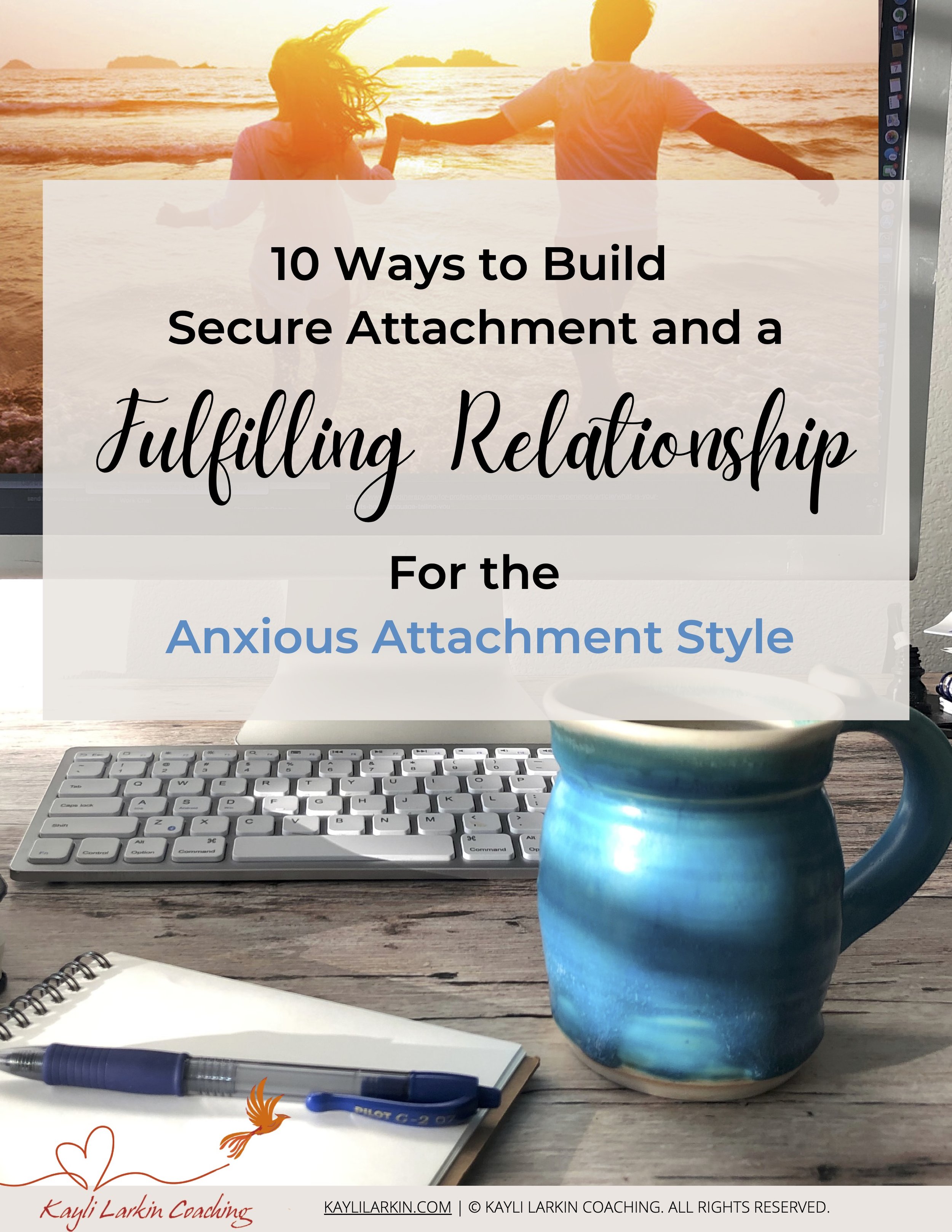
Attachment Styles
in Relationships
Discover the root cause of
your relationship issues.
Many people are surprised by how well attachment theory helps them understand their relationship dynamics. Here you can learn all about attachment and the key role it plays in connection.
How attachment style affects your relationships
What is attachment style anyway?
As children, we bonded, or attached, to a primary caregiver, and the way we connected as babies and children can be described by an attachment style which people typically carry into adulthood. Our attachment style has a huge influence on our behavior in relationships and social interactions.
So what are the main attachment styles?
There are four attachment styles: three insecure and one secure. Terminology varies, but here we will be using the terms anxious, avoidant, disorganized, and secure. Below are descriptions of each type and questions I’m frequently asked of clients.
ANXIOUS ATTACHMENT
Anxious, sometimes referred to as ambivalent, or preoccupied attachment, develops because of an inconsistent or unreliable connection. This creates doubts and anxiety that our needs will be met, and we adapt by hanging on to the connection and wanting excessive reassurance. The words “clingy” or “needy” might be used by an avoidant partner or to describe a strong ambivalent style. We may also have trouble recognizing or accepting love when it’s present, hence the term “ambivalent”. We tend to lose ourselves in our relationships, get stressed out when our partner leaves us or when we are waiting for messages, and become so preoccupied with how our relationships are doing that we have trouble focusing on work or other things we want to do.
Learn more about Anxious Attachment and get the
10 Ways to Build Secure Attachment and a Fulfilling Relationship
for the Anxious Attachment Style
AVOIDANT ATTACHMENT
Avoidant attachment, sometimes called Dismissive Avoidant, is an adaptation in response to a lack of connection, either physical or emotional. This attachment type could develop from having a parent who isn’t around or doesn’t touch or only focuses on tasks rather than loving emotional connection. Because we didn’t have an environment that was safe to be vulnerable or have needs, we learn to rely on ourselves or ignore our needs for others, but that desire to connect is still buried underneath. We adapt by tuning out our needs or learning to meet them ourselves rather than rely on others. We have a strong sense of self and tend to do activities solo rather than engage with someone else or ask for help. We don’t trust other people to be there for us and become independent, sometimes prioritizing career over relationships. We enjoy our alone time and don’t like being interrupted. A partner might describe an avoidant as “dismissive” or “cold” or “emotionally unavailable”.
Learn more about Avoidant Attachment and get the
10 Ways to Build Secure Attachment and a Fulfilling Relationship
for the Avoidant Attachment Style
DISORGANIZED ATTACHMENT
This style — also called Fearful or Fearful Avoidant — is a combination of anxious and avoidant, but with an additional fear component. When a caregiver is dangerous or unpredictable, this can create disorganized attachment, where the survival system and attachment system are cross-wired. Such situations can create anxiety, confusion, and fear, and as a result we have trouble self soothing and regulating our emotions. We can begin to get close to someone and then experience fear and withdraw again. It can be challenging for us to maintain long term relationships.
Learn more about Disorganized (Fearful) Attachment and get the
10 Ways to Build Secure Attachment and a Fulfilling Relationship
for the Disorganized Attachment Style
SECURE ATTACHMENT
This is the ideal attachment created by a healthy bond with a parent. When we are given consistent love and attention — not suffocating, but just the right amount of presence and responsiveness, along with playfulness and protection — we learn that our needs will be taken care of. We learn that from a very young age, we can cry and something good will happen. As adults, we’re comfortable expressing and hearing needs, we're responsive and attuned to our partner. We're playful, and comfortable with closeness and separation because we trust that our partner will return to us.
Frequently Asked Questions
IS IT POSSIBLE TO CHANGE MY ATTACHMENT STYLE?
Yes! The good news is we all have a blueprint for secure attachment, so we’re just addressing the attachment adaptation that got in the way so we can return to secure attachment. It’s also possible to become less secure if we get into a relationship with unhealthy dynamics.
You’ve already taken the first step to becoming more secure because you’ve learned about your attachment style. But knowledge alone is not enough. By learning strategies for your particular style, you can learn to behave in more secure ways and attract more secure people into your life. However, attachment is wired in on the level of the nervous system. At one time, our ability to attach to a parent was required for survival. That’s why people can have such strong feelings come up in relationships that are out of proportion to the situation.
CAN YOU HELP ME BECOME MORE SECURE?
Yes, I’m certified in Dynamic Attachment Re-Patterning and clinical hypnotherapy, and specialize in helping people attract an awesome partner. The work I do is very good for regulating emotions, recognizing and shifting unhealthy patterns of behavior, and developing new habits. I can help you make changes on a deep level faster than if you were to try to become secure through changing your behavior alone.
DO I NEED TO DATE SOMEONE WITH SECURE ATTACHMENT FOR A FEW YEARS TO BECOME SECURE?
No, there are exercises you can do yourself or with a qualified practitioner. But as people shift toward secure attachment, they often find themselves gravitating toward people who are secure.
I TESTED SECURE, BUT FORMER PARTNERS HAVE TOLD ME I’M EMOTIONALLY UNAVAILABLE/AVOIDANT. WHAT’S UP?
People with avoidant attachment sometimes test more secure than they actually are. It’s also possible you dated someone with very strong ambivalent attachment.
I RECENTLY ENDED A TOXIC RELATIONSHIP AND I’M HAVING MORE ANXIETY THAN I’M USED TO HAVING. DOES THIS MEAN MY ATTACHMENT SYSTEM WAS AFFECTED?
It’s possible, but you can can find that underlying safety and security again and learn to trust again — and also learn tools to recognize toxic patterns so you avoid relationships like that in the future.
I’VE TAKEN AN ATTACHMENT QUIZ BEFORE AND SCORED DIFFERENTLY. WHY IS THAT?
Your attachment style can vary based on many factors — not the least of which is who you’re in a relationship with. So you might be secure with one person, and avoidant with another. People can even change within a given relationship. I recommending answering the questions with one relationship in mind.
ARE THERE 3 OR 4 ATTACHMENT STYLES? I’VE NEVER HEARD OF DISORGANIZED ATTACHMENT.
There are 3 insecure styles — Anxious, Avoidant, and Disorganized, and 1 secure style — simply called Secure. Dr. Mary Ainsworth and her colleagues discovered 3 attachment styles, and later, Dr. Mary Main discovered the Disorganized style. The Disorganized style has not historically gotten as much attention, but it is very important and linked to trauma.
WHAT IS ONE STEP I CAN TAKE TODAY THAT WILL HELP ME GET AWAY FROM UNHEALTHY PATTERNS AND CREATE A HEALTHY, SECURE FUNCTIONING RELATIONSHIP?
Read through the 10 Ways to Build to Secure Attachment below for your style and begin incorporating these into your life.














If you tend to lean anxious in relationships—and you’re currently single or navigating the early stages of dating—you’ve probably been told this: date someone secure.
It’s solid advice. But here’s something that rarely gets talked about: not all secure partners feel the same.